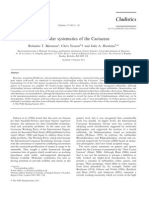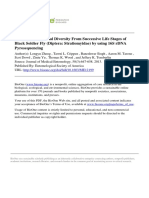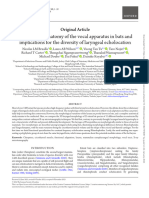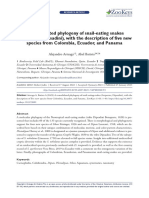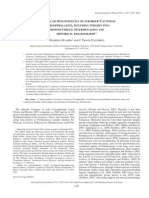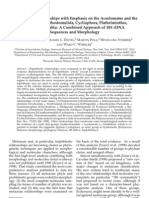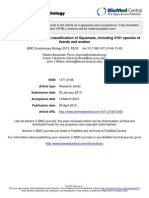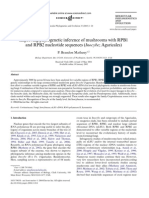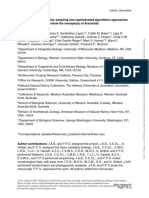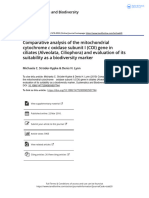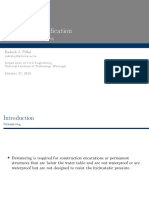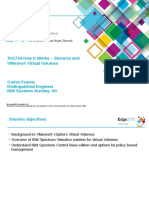Jung 2010
Jung 2010
Uploaded by
Roxana VoicuCopyright:
Available Formats
Jung 2010
Jung 2010
Uploaded by
Roxana VoicuCopyright
Available Formats
Share this document
Did you find this document useful?
Is this content inappropriate?
Copyright:
Available Formats
Jung 2010
Jung 2010
Uploaded by
Roxana VoicuCopyright:
Available Formats
Molecular phylogeny and evolutionary habitat transition of the ower bugs
(Heteroptera: Anthocoridae)
Sunghoon Jung
a
, Hyojoong Kim
a,1
, Kazutaka Yamada
b
, Seunghwan Lee
a,
a
Laboratory of Insect Biosystematics, Division of Entomology, Research Institute for Agricultural and Life Sciences, School of Agricultural Biotechnology, Seoul National
University, San 56-1 Shilim-dong, Gwanak-gu, Seoul 151-742, South Korea
b
Tokushima Prefectural Museum, Bunka-no-Mori Park, Hachiman-ch, Tokushima 770-8070, Japan
a r t i c l e i n f o
Article history:
Received 16 April 2010
Revised 27 August 2010
Accepted 17 September 2010
Available online 1 October 2010
Keywords:
Anthocoridae
Flower bugs
Minute pirate bugs
Phylogeny
Ancestral character states
Bayes traits
Lyctocoridae
Lasiochilidae
a b s t r a c t
We performed a molecular phylogenetic study of the Anthocoridae, the ower bugs, based on maximum
likelihood, maximum parsimony, and Bayesian analyses of 3000 base pairs (bp) of DNA sequence from
the mitochondrial 16S rRNA and nuclear 18S rRNA and 28S rRNA genes for 44 taxa. Our phylogenetic
analyses indicates that (i) the tribe Cardiastethini (Dufouriellini) could be a paraphyletic group, as the
genera Amphiareus and Dysepicritus are not included in the tribe; (ii) the main subgroups, Oriini and
Anthocorini, are monophyletic within Anthocoridae; (iii) three tribes of Blaptostethini, Xylocorini, and
Scolopini are separated from the main anthocorid clade which is composed of Anthocorini, Cardiastethini,
and Oriini, suggesting that Anthocoridae could not be monophyletic. We compared our molecular
phylogeny to previous hypotheses of evolutionary relationships within Cimicoidea based on different
anthocorid classication systems using alternative hypothesis tests (KishinoHasegawa and Shimodaira
Hasegawa tests). BayesTraits were used to examine the ancestral character states inferring historical
habitat patterns of the Anthocoridae. Reconstruction of the ancestral habitat patterns of the Anthocoridae
suggests that deadplants may have served as animportant habitat for the commonancestor of anthocorids.
The biological events such as diversication of angiosperms and anthocorid prey might have provided
anthocorids with more habitat options, such as living plants; thereafter, Anthocorini and Amphiareus
appeared to have evolved increasingly specialized habitat relationships.
2010 Elsevier Inc. All rights reserved.
1. Introduction
Insects in the family Anthocoridae (Hemiptera: Heteroptera),
sometimes referred to as ower bugs or minute pirate bugs, are
small in size (1.44.5 mm). This family contains approximately
400600 species that are distributed worldwide (Pricart, 1972;
Schuh and tys, 1991; Pricart, 1996). Most species of Anthocoridae
are predaceous as nymphs and adults (Anderson, 1962c; Pricart,
1972; Lattin and Stanton, 1992), thus some species, such as Orius
laevigatus, O. strigicollis and O. insidiosus, are used as biological con-
trol agents and are commercially produced and traded (Yasunaga,
1997a; Kim et al., 2008). However, some species in this family con-
sume both plants and other insects and their eggs (Carayon and
Steffan, 1959; Chu, 1969; Pricart, 1972; Salas-Aguilar and Ehler,
1977; Armer et al., 1998). A few species appear to be entirely phy-
tophagous (Bacheler and Baranowski, 1975). Lattin (1999)
published a comprehensive review of the general biology and
bionomics of Anthocoridae, including a discussion of their use as
biological control agents.
Following the proposal of the infraorder Cimicomorpha by
Leston et al. in (1954), Carayon (1972) proposed a classication
of Anthocoridae that included three subfamilies: Anthocorinae,
Lyctocorinae, and Lasiochilinae (Fig. 1A; Table 1). Subsequently,
Ford (1979) and Schuh (1986) pointed out that Carayons Anthoco-
ridae may not be a monophyletic group. Schuh and tys (1991)
constructed a cladistic tree of relationships within Cimicomorpha,
and based on this tree, they elevated Carayon (1972)s three
subfamilies to family level (Lasiochilidae, Anthocoridae, and Lycto-
coridae) (Fig. 1B), and moved all the tribes in the subfamily Lycto-
corinae to the family Anthocoridae, except for the tribe Lyctocorini,
which was treated as a separate family (Table 1). After this revi-
sion, Cassis and Gross (1995) downgraded the rank of the three
families to the subfamily-level (Table 1). By elevating the three
subfamilies of Anthocorinae, Lyctocorinae, and Lasihchilinae to
family level (sensu Schuh and tys), the hypotheses of relation-
ships within Cimicoidea also changed (e.g., the position of Plokio-
philidae and Nabidae, Figs. 1A and B). Therefore, to perform a
phylogenetic study of the Anthocoridae, the relationships of higher
taxa within Cimicoidea should also be considered.
1055-7903/$ - see front matter 2010 Elsevier Inc. All rights reserved.
doi:10.1016/j.ympev.2010.09.013
Corresponding author. Fax: +82 2 873 2319.
E-mail address: seung@snu.ac.kr (S. Lee).
1
Present address: Department of Life Sciences and Division of EcoScience, Ewha
University, Seoul 120-750, South Korea.
Molecular Phylogenetics and Evolution 57 (2010) 11731183
Contents lists available at ScienceDirect
Molecular Phylogenetics and Evolution
j our nal homepage: www. el sevi er. com/ l ocat e/ ympev
The main aim of this study was to apply molecular evidence to
construct the phylogenetic relationships of the Anthocoridae for
the rst time, and to test the two current hypotheses of higher taxa
relationships within Cimicoidea (Kerzhner, 1981; Schuh and tys,
1991; Fig. 1) to clarify the various classications of Anthocoridae
(Table 1) based on molecular data. In addition, the ancestral habi-
tat patterns of anthocorids were assessed using a Bayesian ap-
proach with node-free rates of habitat exchange. Based on our
results, we propose an evolutionary habitat history of the
Anthocoridae.
2. Materials and methods
2.1. Taxon sampling
A total of 44 species including six outgroup species were se-
lected for molecular analysis (Table 2). Family relationships within
the infraorder Cimicomorpha based on morphological, molecular,
or combined data (Kerzhner, 1981; Schuh and tys, 1991; Tian
et al., 2008; Schuh et al., 2009) are largely similar. However, recent
molecular-based phylogenetic studies of cimicomorphan family
relationships are incomplete, because Lasiochilidae or/and Lycto-
coridae were not included (Tian et al., 2008; Schuh et al., 2009).
We selected outgroup taxa according to hypotheses of cimicom-
orphan relationships based on morphological or/and biological
data as proposed by Kerzhner (1981) and Schuh and tys (1991)
(Fig. 1A and B). We selected three outgroup species from Nabidae
and three from Cimicidae and Plokiophilidae as these families are
closely related to the Anthocoridae (Fig. 1A and B). The most recent
study of family-level relationships within Cimicomorpha using
molecular and morphological data was conducted by Schuh et al.
(2009); nabids formed a sister group to the Cimicoidea (Anthocori-
dae + Lyctocoridae + Lasiochilidae + Cimicidae + Plokiophilidae),
which is why we used nabids as an outgroup in this study. Addi-
tionally, according to Schuh and tyss (1991) cimicomorphan rela-
tionships (Fig. 1B), Plokiophilidae is positioned between two
elevating families, Lyctocoridae and Lasiochilidae (sensu Schuh
and tys, 1991), and Cimicidae is the most derived group within
the Cimicoidea, thus species in Plokiophilidae and Cimicidae were
also selected as sub-outgroups in this study.
Because the classication and taxon rank of Anthocoridae are
controversial (Table 1), 38 species from three subfamilies (Antho-
corinae, Lyctocorinae and Lashiochilinae) were selected as ingroup
taxa based on Carayons (1972) classication (Table 2), regardless
of the diverse subfamily or tribal designations.
2.2. DNA extraction, PCR amplication, and sequencing
Total genomic DNA was extracted from single individuals using
GENEALL
(Exgene
Tissue SV) according to the manufacturers
protocol. A hole was made in the cuticle of each individual, and
the sample was incubated at 56 C in AE buffer and proteinase K.
After incubation, cuticle samples with a genital segment were used
to make macerated slide specimens for voucher specimens. PCRs
were performed using Advantage PCR II Taq polymerase (BD
Advantage) and the reactions were performed in 20 ll volumes
containing 0.4 lm of each primer, 200 lm dNTPs, 2.5 lm MgCl
2
,
and 0.05 lg genomic DNA template. The thermal cycling program
consisted of 40 cycles of 92 C/30 s, 4352 C/30 s, and 72 C/60 s,
followed by a nal extension at 68 C/10 min. The PCR products
were cleaned using a QIAquick
PCR purication kit (QIAGEN,
Inc.), and directly sequenced at NICEM (National Instrumentation
Center for Environment Management, Seoul National University,
Republic of Korea). The nuclear 18S ribosomal gene, 28S ribosomal
gene D3 region, and a portion of the mitochondrial 16S ribosomal
gene were chosen as molecular markers. Those genes were used in
molecular systematics, especially within the cimicomorphans (In-
secta: Heteroptera), and were targeted due to their relative ease
of amplication and the possibility of integrating data into a broad-
er framework within Heteroptera (Wheeler et al., 1993; Tian et al.,
2008; Schuh et al., 2009; Weirauch and Munro, 2009).
Fig. 1. Current hypotheses of family relationships within Cimicoidea. (A) Clado-
gram after Kerzhner (1981), redrawn, and classication system by tys and
Kerzhner (1975). (B) Cladogram after Schuh and tys (1991) and their classication
system.
Table 1
Various classication of Anthocoridae (taxa used in this study; modied after Jung
and Lee, 2007).
Carayon (1972) Schuh and tys (1991) Cassis and Gross (1995)
ANTHOCORINAE ANTHOCORIDAE ANTHOCORINAE
ANTHOCORINI ANTHOCORINI ANTHOCORINI
Anthocoris Anthocoris Anthocoris
Tetraphleps Tetraphleps Tetraphleps
BLAPTOSTETHINI BLAPTOSTETHINI BLAPTOSTETHINI
Blaptostethus Blaptostethus Blaptostethus
ORIINI CARDIASTETHINI
(Dufouriellini)
CARDIASTETHINI
(Dufouriellini)
Orius Amphiareus Amphiareus
Bilia Buchananiella Buchananiella
Montandoniola Cardiastethus Cardiastethus
Dysepicritus Dysepicritus
LASIOCHILINAE Physopleurella Physopleurella
Lasiochilus ORIINI ORIINI
Orius Orius
LYCTOCORINAE Bilia Bilia
CARDIASTETHINI
(Dufouriellini)
Montandoniola Montandoniola
Amphiareus SCOLOPINI SCOLOPINI
Buchananiella Scoloposcelis Scoloposcelis
Cardiastethus XYLOCORINI XYLOCORINI
Dysepicritus Xylocoris Xylocoris
Physopleurella
LYCTOCORIINI LASIOCHILIDAE LASIOCHILINAE
Lyctocoris Lasiochilus Lasiochilus
XYLOCORINI
Xylocoris LYCTOCORIDAE LYCTOCORINAE
SCOLOPINI Lyctocoris Lyctocoris
Scoloposcelis
1174 S. Jung et al. / Molecular Phylogenetics and Evolution 57 (2010) 11731183
Table 2
Taxa used in this study with GenBank accession numbers, employing Carayon (1972)s classication; Note: Taxa, whose sequence accession number started with GQ were sequenced from this research. Other sequence from NCBI
(Tian et al., 2008; Schuh et al., 2009); DC: habitats are conrmed by direct collection. Type coding is explained in the text.
Family: Tribe Species Collecting country Type coding Habitat references Accession Number
Subfamily 18S rDNA 28S rDNA 16S rDNA
Anthocoridae: Oriini Orius atratus Japan AB Yasunaga (1997a); DC GQ258414 GQ258449 GQ258387
Anthocorinae O. laevigatus Netherland A Pricart (1972) GQ258416 GQ258451 GQ258371
O. niger Nepal A Pricart (1972); DC GQ258418 GQ258453 GQ258392
O. agilis A Kerzhner (1988) EF487296 EF487333 EF487274
O. insidiosus U.S.A A Pricart (1972) GQ258415 GQ258450 GQ258390
O. sauteri Korea AB Yasunaga (1997b); DC GQ258419 GQ258454 GQ258373
O. minutus Korea AB Yasunaga (1997b); DC GQ258417 GQ258452 GQ258372
O. strigicollis Netherland AB Yasunaga (1997b); DC GQ258420 GQ258455 GQ258374
Bilia sp. Nepal A DC GQ258406 GQ258439 GQ258363
Montandoniola moraguesi Korea AB Pricart (1972); DC GQ258413 GQ258448 GQ258370
Anthocorini Anthocoris confusus Korea B Kerzhner (1988); DC GQ258401 GQ258431 GQ258359
A. hsiaoi A Bu and Zheng (2001) EF487306 EF487325 EF487285
A. montanus Unknown EF487307 EF487326 EF487284
A. chibi Korea B Hiura (1959); DC GQ258403 GQ258437 GQ258362
A. avipes B Pricart (1972) EF487309 EF487318 EF487289
A. miyamotoi Korea B Kerzhner (1988); DC GQ258405 GQ258438 GQ258361
A. thibetanus Unknown EF487314 EF487335 EF433419
A. gracilis Nepal B DC GQ258402 GQ258432 GQ258391
A. japonicus Korea B Hiura (1959); DC GQ258404 GQ258436 GQ258360
A. pilosus AB Bu and Zheng (2001) EF487302 EF487334 EF487277
A. zoui Unknown EF487303 EF487330 EF487275
Tetraphleps aterrimus Japan B Kerzhner (1988); DC EF487295 EF487323 EF487273
Anthocoridae: Dufouirellini Amphiareus rucollaris Japan C Yamada and Hirowatari (2003); DC GQ258394 GQ258430 GQ258383
Lyctocorinae A. obscuriceps Korea C Yamada and Hirowatari (2003); DC GQ258393 GQ258429 GQ258358
A. constrictus Japan C Pricart (1972); DC GQ258397 GQ258427 GQ258359
A. morimotoi Japan C Yamada and Hirowatari (2003); DC GQ258398 GQ258428 GQ258361
Buchananiella crassicornis Malaysia C Yamada and Hirowatari (2007b); DC GQ258407 GQ258441 GQ258364
B. leptocephala Malaysia C Yamada and Hirowatari (2007b); DC GQ258408 GQ258442 GQ258365
Dysepicritus rufescens Japan C Yamada and Hirowatari (2002); DC GQ258399 GQ258444 GQ258386
Physopleurella armata Korea BC Yamada and Hirowatari (2007a); DC GQ258421 GQ258456 GQ258375
Cardiastethus exguus Korea BC DC GQ258409 GQ258443 GQ258366
Scolopini Scoloposcelis albodecussata Japan D Yamada and Hirowatari (2005a); DC GQ258422 GQ258457 GQ258376
S. sp. Korea D DC GQ258423 GQ258458 GQ258377
Xylocrini Xylocoris cerealis Thailand C Yamada et al. (2006); DC GQ258395 GQ258459 GQ258384
Blaptostethini Blaptostethus aurivillus Malaysia AC Yamada (2008); DC GQ258400 GQ258440 GQ258388
Lyctocorini Lyctocoris benecus Korea C Hiura (1966); DC GQ258412 GQ258447 GQ258369
Anthocoridae: Lasiochilus japonicus Korea D Jung and Lee (2007); DC GQ258410 GQ258445 GQ258367
Lasiochilinae L. luceonotatus Japan D Yamada and Hirowatari (2005c); DC GQ258408 GQ258446 GQ258368
Nabidae Nabini Nabis stenoferus Korea GQ258426 GQ258434 GQ258379
Nabini N. avomarginatus Korea GQ258424 GQ258433 GQ258380
Nabini Himacerus apterus Korea GQ258425 GQ258435 GQ258381
Cimicidae Cimex lectularius U.S.A GQ258396 GQ258460 GQ258382
C. sp. AY252231 AY252474 AY252702
Plokiophilidae Lipolophila eberhardi AY252148 AY252432 AY252661
S
.
J
u
n
g
e
t
a
l
.
/
M
o
l
e
c
u
l
a
r
P
h
y
l
o
g
e
n
e
t
i
c
s
a
n
d
E
v
o
l
u
t
i
o
n
5
7
(
2
0
1
0
)
1
1
7
3
1
1
8
3
1
1
7
5
The complete 18S rRNA gene was amplied using primer pairs
18S-1 (5-CTGGTTGATCCTGCCAGTAGT-3)/18S-4 (5-GATCCTTCT
GCAGGTTCACC-3) (Campbell et al., 1995), and sequenced using
the internal primers 18S-2 (5-AGATACCGCCCTAGTTCTAACC-3)
and 18S-3(5-GGTTAGAACTAGGGCGGTATCT-3) with 18S-1 and
18S-4, respectively. The annealing temperature was 4850 C.
The D3 region of 28S rRNA gene and a partial fragment of the mito-
chondrial 16S rRNA were amplied using primer pairs 28S-DD
(5-GGGACCCGTCTTGAAACAC-3)/28S-FF (5-TTACACACTCCTTAGC
GGAT-3) (Hillis and Dixon, 1991) and 16S-A (5-CGCCTGTTTAACA
AAAACAT-3) (Simon et al., 1994)/16S-B (5-CCGGTTGAACTCAGAT
CA-3) (Kambhampati and Smith, 1995). The annealing tempera-
tures were 45 C and 50 C, respectively.
2.3. Alignment and characterization of gene fragments
For the alignments, we retrieved GenBank reference sequences
for the three gene regions (Tian et al., 2008) with which to compare
our sequences. Raw sequences were examined and corrected using
SeqManII (version 5.01, 2001; DNA-star). All DNA sequences
were aligned using CLUSTAL X (version 1.83, 2003; Thompson
et al., 1997; default settings), MEGA 3.1 (Kumar et al., 2004), and
MAFFT (Katoh et al., 2002; Katoh et al., 2005) of the online sever
(v.6; <http://align.bmr.kyushu-u.ac.jp/mafft/online>). As the three
genes used in this study contain lots of gaps, to avoid bias in ren-
ing alignments, we compared the result using the three aligning
programs. Some ambiguous sites in the three gene fragments were
removed using GBLOCK 0.91b (Castresana, 2002; default settings
were used except for choosing the gap option with half).
2.4. Saturation tests
Given that nucleotide saturation can result in incorrect phylo-
genetic inferences (Swofford et al., 1996), uncorrected pairwise se-
quence distances were plotted against the numbers of transition
and transversion substitutions using MEGA 3.1 (Kumar et al.,
2004) to estimate the extent to which the DNA sequences were
saturated.
2.5. Phylogenetic analyses
Maximum parsimony (MP) analysis was implemented in
PAUP*4.0b10 (Swofford, 1998) using a heuristic search procedure,
tree bisection reconnection (TBR) branch swapping, and 1000 ran-
domsequence additions with 10 trees held at each pseudoreplicate.
All characters were treated as unordered and equally weighted for
MP analysis. One thousand MP bootstrap replicates were performed
using a heuristic search procedure, with a maximum tree setting of
200 trees. Decay index values (Bremer, 1988) were also calculated
to determine branch support using TreeRot V3 (Sorenson and
Farnzosa, 2007). The partition-homogeneity test (Farris et al.,
1994), as implemented in PAUP*, was performed to test for signi-
cant phylogenetic conict between the three gene fragments.
For maximum likelihood (ML) analysis, MODELTEST version
3.06 (Posada and Crandall, 1998) was used to select the best-tting
nucleotide substitution model, and then PAUP* settings were opti-
mized using data of the selected model before searching. ML anal-
yses were also performed with PAUP* using the heuristic search
procedure with TBR branch swapping, 100 random additions of se-
quences, and 10 trees held at each pseudoreplicate. One hundred
ML bootstraps were performed using a heuristic search procedure
and a maxtree setting of 200 trees.
Bayesian phylogenetic (BP) analysis was implemented in
MRBAYES (version 3.1.1; Ronquist and Huelsenbeck, 2003) for
the single and combined datasets. We analyzed the combined
dataset using two different methods (Supplementary data 4): (1)
partitioned Bayesian analysis (PBA), in which the data were parti-
tioned into 18S rRNA, 16S rRNA and 28S rRNA segments, with BP
performed using a partition scheme that maximized the likelihood
based on the GTR + I + G model with specic model scores esti-
mated by the MODELTEST for each gene region; (2) non-specic
model scores Bayesian analysis (NBA), in which, as for ML analysis,
we applied the GTR + I + G nucleotide substitution model with var-
iable model scores to the partitioned dataset. For the BP analyses of
the above two methods, four chains (three heated and one cold)
were run, starting from a random tree and proceeding for 10 mil-
lion Markov chain Monte Carlo (MCMC) generations, sampling
the chains every 100th cycle. To ensure that the distribution had
stabilized, Tracer version 1.4 (Rambaut and Drummond, 2008)
was used to view the graphical representation of MCMC chain mix-
ing. Burn-in was set at 15% of the sampled number of trees. Con-
vergence was conrmed by monitoring likelihood values
graphically. A 50% majority-rule consensus tree was constructed
from the remaining trees to estimate posterior probabilities (PP).
2.6. Evaluation of alternative hypotheses of relationships within
Cimicoidea
To assess whether there was signicant conict between previ-
ous phylogenetic hypotheses (Fig. 1) within Cimicoidea and our
molecular phylogeny, we employed the KishinoHasegawa (KH)
test (Kishino and Hasegawa, 1989) and ShimodairaHasegawa
(SH) test (Shimodaira, 2001, 2002). First, we reconstructed alterna-
tive, fully-resolved tree topologies consistent with the previous
taxonomic schemes or hypotheses of Kerzhner (1981) and Schuh
and tys (1991) (Fig. 1) using Mesquite version 2.6 (Maddison
and Maddison, 2007). To test Kerzhners hypothesis (Fig. 1A) based
on the classication of Carayon (1972), Table 1) for Anthocoridae,
we removed Velocipedidae and Polyctenidae, and combined
Medocostinae, Nabidae, and Prostemmatinae into a single group,
Nabidae, and constrained the anthocorid taxa based on Carayons
classication (1972) (Table 1). To test Schuh and tys hypothesis
(Fig. 1B), we also excluded Polyctenidae, and made Nabidae
(Naboidea) the sister group of all the taxa within Cimicoidea based
on the hypothesized family relationships within Cimicomorpha,
and constrained the anthocorid taxa based on the Anthocoridae
classications of Schuh and tys (1991) (Table 1). Second, we per-
formed ML heuristic searches under a GTR + I + G model for each
gene partition, and topological constraints were incorporated in
RAxML v.7.0 (Stamatakis, 2006) to evaluate the highest-likelihood
topology that satised the given hypothesis. In the third step, we
compared the ML tree obtained from this study with the two topol-
ogies from the rst and second steps using 2000 bootstraps and
RELL optimization of the concatenated dataset in PAUP*4.0b10.
2.7. Ancestral character states of anthocorids
To explore the relationships between divergence and ancestral
habitat patterns of Anthocoridae, we used the habitat types of
anthocorids, and applied the Bayesian estimation of ancestral
character states referencing phylogenetic result. Outgroup taxa,
Nabadae: Nabinae, damsel bugs including sub-outgroup taxa,
Cimicidae and Plokiophilidae, ectoparasites and cobweb dwellers,
respectively, were not included in the part of the study.
2.7.1. Habitat types
The ancestral habitats of Anthocoridae were inferred based on
the habitats occupied by extant taxa. Table 2 indicates the habitats
for each species used in this study. Although the host plants of spe-
cic taxa are usually reported in taxonomic papers, we collected
most anthocorid species in this study to conrm their habitats.
Although we collected Blaptostethus aurivillus from live owers of
1176 S. Jung et al. / Molecular Phylogenetics and Evolution 57 (2010) 11731183
Macaranga (Euphorbiaceae) from Malaysia, most taxa belonging to
Blaptostethus inhabit dead plant materials such as clusters of veg-
etable refuse and the nests of weaverbirds (Carayon, 1972). There-
fore, we specied that this species inhabits both living and dead
plants in our analysis.
Habitat types were coded according to the references (Table 2)
as follows: (A) living forbs (including owers of plants); (B) living
trees (including shrubs); (C) dead leaf clusters; (D) under the bark
of dead tree. Each species was assigned to one or two habitat types
based on reference papers and information collected in this study,
with the exceptions of Anthocoris montanus, A. thibetanus, and
A. zoui because of lack of habitat information.
2.7.2. Bayesian estimation of ancestral character states
A Bayesian approach as implemented in the BayesTraits (PC ver-
sion 1.0) software package (Pagel et al., 2004; Pagel and Meade,
2007) was used to reconstruct ancestral habitat character states
for selected nodes in the partitioned Bayesian phylogenetic analy-
sis (PBA). BayesTraits uses reversible-jump Markov chain Monte
Carlo (MCMC) methods to derive posterior probabilities and the
values of traits at ancestral nodes of phylogenies (Pagel et al.,
2004). BayesMultiState was selected as model of evolution and
MCMC as the method of analysis. Because some taxa occurred in
two habitats, we used the multiple character state option of Bayes-
Multistate. For example, the code AB signied that the habitat type
could be state A or B (with equal probability) but not state C or D
(Pagel and Meade, 2007). The rate deviation was set to 10. A hyper-
prior approach was employed with an exponential prior seeded
from a uniform prior in the interval 010. Thus, acceptance rates
in the preferred range of 2040% were achieved as recommended
(Pagel et al., 2004; Pagel and Meade, 2007). A total of 50 million
iterations were run for each analysis with the rst one million
samples discarded as burn-in, with sampling every 1000th gener-
ation. Because the posterior probabilities for ancestral habitat
patterns of the single runs differed slightly, we calculated the
arithmetic mean of all samples for reconstruction of ancestral
habitat types.
3. Results
3.1. Characteristics of the three gene fragments
The alignment results of the each gene region used in this study
using the three aligning programs are almost identical to each
other. The mitochondrial 16S rRNA dataset comprised 419 aligned
base pairs (bp), but some ambiguous sites were further excluded
using GBLOCK 0.91b with the half-option. Among the selected
399 bp, 253 bp were variable and 212 bp were parsimony informa-
tive. The average of the uncorrected sequence divergence among
taxa for 16S rRNA was 16.3%, and the average proportions of
T:C:A:G were 44:10:31:15. The AT richness observed is character-
istic of insect mitochondrial DNA sequences (Tauz et al., 1988;
Crozier and Crozier, 1993). The nuclear 18S rRNA dataset com-
prised 1949 bp of aligned sequences, but some ambiguous sites
were excluded using GBLOCK 0.91b with the half-option. Among
the selected 1565 bp, 408 bp were variable and 245 bp were parsi-
mony informative. The average of the uncorrected sequence diver-
gence among taxa for 18S rRNA was 4.8%, and the average
proportions of T:C:A:G were 24:23:25:28. For the nuclear 28S
rRNA dataset, 657 bp of sequences were aligned for all taxa, but
some ambiguous sites were excluded using GBLOCK 0.91b with
the half-option. Among the nal 552 bp, 136 bp were variable
and 85 bp were parsimony informative. The average uncorrected
sequence divergence of the 28S rRNA gene among taxa was
16.3%, while the average proportions of T:C:A:G were 27:21:26:26.
3.2. Substitution patterns
Uncorrected P-distances were plotted against the number of
transitions (Ts) and transversions (Tv). Tests were performed for
all three genes and the combined dataset. All three genes and com-
bined dataset were free of saturation; Ts and Tv values increased
linearly according to increasing uncorrected P-distances.
3.3. Phylogenetic analyses
3.3.1. Analyses of the single-gene datasets
Single datasets were analyzed by Bayesian analyses using the
GTR + I + G model selected as the best-t model for each of the
three genes by MODELTEST. For the individual-level phylogenetic
analyses of the three individual datasets (18S/16S/28S rRNA; Sup-
plementary Figs. 13), the branch support values were insufcient
to resolve relationships between lower taxa, but major nodes sub-
tending generic or tribal clusters were highly supported. The
monophyly of the Oriini was supported robustly in all three anal-
yses (PB = 100), and the monophyly of the Anthocorini and the Car-
diastethini except for the two genera Amphiareus and Dysepicritus
were clearly supported in all three analyses. The monophyly of
the genus Amphiareus was clearly supported by the 18S/16S rDNA
data (PB = 100).
3.3.2. Analyses of the combined dataset
For MP analyses, the partitionhomogeneity test found signi-
cant phylogenetic conict among all possible data partitions (gen-
erally P = 0.001). Nevertheless, there was no conict between
major nodes found in the analysis of individual datasets. Thus,
the concatenated data set was analyzed. MP analysis yielded three
equally parsimonious trees with a tree length of 2722. The MP (PP)
and decay index (DI) values for the strict consensus cladogram of
the three most parsimonious trees are shown in Table 3. For ML
analyses, the GTR + I + G model selected by MODELTEST analysis
as the most suitable for the combined dataset were used. ML anal-
ysis produced a single tree which was identical to the post-burn-in
consensus tree from NBA based on the GTR + I + G model for the
combined dataset. Bootstrap P-values (PL) for nodes in the ML tree
(ln L = 16765.98997) and PB of the NBA analysis are presented in
Table 3. Nodal supports for several nodes differed between the PBA
topology and the ML and NBA topologies. The topology and nodal
support values for major nodes based on the PBA analysis are
marked with capital letters in Fig. 3 and Table 3.
The monophyly of the superfamily Cimicoidea, all the remain-
ing taxa excluding Nabidae: Nabinae, were well supported by high
P-values (Fig. 2, node A). The family Lyctocoridae with tribes, Blap-
tostethini and Xylocorini, was poorly resolved in all analyses, but
Xylocorini clustered with Cimicidae + Plokiophilidae (Fig. 2, node
L), and Blaptostethini was positioned most basally except Lasiochi-
lidae within Cimicoidea (Fig. 2 node B), both of which separate
from the main Anthocoridae node (Fig. 2, node D) in the PBA
(ML, NBA) tree. The main Anthocoridae (Fig. 2, node D), including
the three tribes Oriini, Cardiastethini, and Anthocorini, was well-
supported (Table 3). The monophyly of the tribe Anthocorini
(Fig. 2, node E; Table 3) had strong support and included two
genera, Anthocoris and Tetraphleps. The genus Anthocoris was recov-
ered as paraphyletic group, clustering together with Tetraphleps
aterrimus. The monophyly of the genus Amphiareus (A. rucollaris,
A. obscuriceps, A. constrictus and A. morimotoi) (Fig. 2, node F; Table 3)
was well supported. In contrast, the two genera, Amphiareus and
Dyspicritus were separated from the main clade of tribe Cardiasteth-
ini (Fig. 2, node I), and clustered with Anthocorini (Fig. 2, node
N + R). The remaining members of Cardiastethini (Cardiastethus
exguus, Physopleurella armata, Buchananiella crassicornis and
B. leptocephala) (Fig. 2, node I; Table 3) formed a clade with strong
S. Jung et al. / Molecular Phylogenetics and Evolution 57 (2010) 11731183 1177
support. Therefore, Cardiastethini is not monophyletic due to the
separation of nodes F, node I, and Dysepicritus rufescens. Oriini was
composed of 10 species from three genera (Bilia sp., Montandonilola
moraguesi, Orius atratus, O. laevigatus, O. niger, O. agilis, O. insidiosus,
O. sauteri, O. minutus and O. strigicollis) and was monophyletic with
strong support (Fig. 2, node G; Table 3) while the subgenus Heterorius
was strongly supported by all analyses (Fig. 2, node P; Table 3).
In terms of the relationships between tribes and genera, Oriini
and Cardiastethini without the two genera Amphiareus and
Dysepicritus clustered together with moderate support on the ML,
BP (NBA, PBA), and MP trees (Fig. 2, node H; Table 3). Amphiare-
us + Dysepicritus and Anthocorini were sister clades on ML/BP
(NBA, PBA) and MP trees with relatively low support values
(Fig. 2, nodes N, R; Table 3). In the ML/BP (NBA, PBA) analyses,
Dysepicritus rufescens was basal to both node E (Anthocorini) + node
F (Amphiareus) with high support values (Table 3), and node F
(Amphiareus) clustered with node E (Anthocorini) with low support
values (Table 3).
3.4. Comparisons of alternative hypotheses within Cimicoidea
One of the two previous phylogenetic hypotheses within Cimi-
coidea was rejected on the basis of the KishinoHasegawa (KH)
and ShimodairaHasegawa (SH) tests (Table 4, P-value <0.05).
The hypothesis of Kerzhner (1981) differs from our molecular phy-
logeny in all the placements of families within Cimicoidea, regard-
less of the rank and the classication of the three subfamilies
Lashiochilinae, Lyctocorinae, and Anthocorinae (Carayon, 1972).
The hypothesis of Schuh and tys (1991) conicts with the
molecular phylogeny in several areas, particularly the relationship
Fig. 2. Phylogenetic relationships inferred from Bayesian analysis based on a GTR + I + G model with specic model scores for each gene partition (PBA) with posterior
probabilities (PP) under nodes. Thick branches indicate nodes also recovered in the other analyses. Capital letters on the nodes refer to nodes discussed in the text and support
values from other analyses are provided in Table 3. Higher-taxa names on the right side of the topology are based on Schuh and tys (1991)s classication with colored bar
regarding to the general habitat type for each higher taxon group. Gray boxes indicate taxa used as outgroup in this study. The habitat types of each species are color-coded
according to the four patterns of habitats (Table 2). BayesMultistate analysis results of ancestral habitat type reconstructions are indicated as pie charts under the nodes
showing the relative likelihoods of each habitat type at respective nodes.
1178 S. Jung et al. / Molecular Phylogenetics and Evolution 57 (2010) 11731183
between Cimicidae and Plokiphilidae, and the placement of several
tribes of the Anthocoridae. However, as the P-values of the KH and
SHtests were greater than 0.05, our molecular phylogeny partly
supports Schuh and tys (1991)s hypotheses of relationships
within Cimicoidea and the classication of Anthocoridae (with
Lyctocoridae and Lasiochilidae, Table 1), including the family level
rank of Lasiochilidae.
3.5. Ancestral character states analysis
Ancestral habitat types were estimated for the 10 nodes of high-
er taxa relationships in the Bayesian trees (Fig. 2; pie charts).
BayesMultiState analyses allowed free rates of habitat types
exchange between the four habitat types (Table 2). The analysis
suggests that the habitat type coded as C + D (dead leaf
clusters + bark of the dead tree: dead plant; light blue and dark blue
in Fig. 2, node A) at the root of Cimicoidea (Schuh and tys, 1991)
Fig. 3. Simplied view of higher taxa relationships for the hypothesized Anthocoridae (node D) found in this study showing the patterns of the change of habit type and
range. Capital alphabets and splits 13 for the nodes are corresponded with ones in Fig. 2 and discussed in the text, respectively. Species used as representatives of higher
groups are as follows: Physopleurella armata for Cardiastethini, Orius sauteri for Oriini, Amphiareus obscuriceps for Amphiareus, and Anthocoris confusus for Anthocorini.
Table 3
Clade recovered in the four analyses, maximum parsimony (MP), maximum likelihood (ML), and Non-specic model scores Partitioned Bayesian Analysis (NBA) and Partitioned
Bayesian Analysis with specic model scores for each partition (PBA) using PAUP and MrBayes. Values for MP with Decay Index (DI) and ML are boostrap values, those for the
MrBayes posterior probabilities. Indicates that a particular clade is not recovered in that analysis or values below 50.
Taxa clades Node on Fig. 2 MrBayes PAUP
NBA PBA MP DI ML
Cimicoidea A 1 1 98 29 95
Cimicoidea excluding Lasiochilidae B 1 0.85 100 30 100
Cimicoidea excluding Blaptostethini and Lasiochilidae C 0.78 1 65 1 57
Anthocoridae D 1 1 67 2 90
Anthocorini E 1 1 100 5 100
Amphiareus F 1 1 100 26 100
Oriini G 1 1 100 52 100
Cardiastethini + Oriini H 1 1 85 2 75
Cardiastethini I 1 1 100 21 100
Anthocoridae + Lyctocoridae J 0.57
Cimicidae + Plokophilidae K 1 1 68 1 95
Xylocorini + Cimicidae + Plokophilidae L 0.95 0.94 57
Lasiochilidae M 1 1 100 12 100
Anthocorini + Amphiareus + Dysepicritus N 0.99 0.97 90
Scolopini O 1 1 100 48 100
Subgenus Heterorius P 1 1 100 12 99
Cimicoidea excluding Lasiochilidae, Blaptostethini and Scolopini Q 0.78 0.98
Amphiareus + Anthocorini R 0.88 0.85 59
Table 4
Result from KishinoHasegawa (KH) and ShimodairaHasegawa (SH) tests among
tree topologies (within Cimicoidea). Previously proposed hypotheses (see Fig. 1) were
used to nd a ML tree under those constraints, and those trees were compared with
the ML tree (best). Maximum likelihood values (L) are reported for each tree and the
difference in log likelihoods (dif Ln L) between the proposed tree and the best tree is
used to assess statistical signicance of the test. Tests were run in PAUP. *P < 0.05.
ln L Dif ln L KH-test P SH-test P
Kerzhner (1981) 16861.76850 96.99891 0.007* 0.0045*
Schuh and tys (1991) 16779.24136 14.47177 0.3245 0.438
Best 16764.76959
S. Jung et al. / Molecular Phylogenetics and Evolution 57 (2010) 11731183 1179
had a reconstructed probability of greater than 90% compared to
alternative habitat types. On the next-most distal bifurcations after
the split of Lasiochilidae from the remaining taxa within Cimicoi-
dea, the ancestral habitat types are reconstructed as types C that
code for dead leaf clusters with the reconstructed probabilities
for the type was more than 90% (Fig 2, nodes B). The habitat ranges
for ancestral character states for the ancestor of the three tribes,
Anthocorini, Oriini, and Cardiastethini (Fig. 2, nodes H, R + N) sug-
gest that a mixture of live and dead plants were the ancestral hab-
itat type for the main lineages of Anthocorini, Oriini and
Cardiastethini. However, the analyses indicated that dead plants,
especially dead leaf clusters, were more likely to have been the
habitat type of the common ancestor of these main groups than liv-
ing plants (Fig. 2, node D) although the ancestral habitats of the
two tribes, Oriini and Anthocorini, were reconstructed as living
plants (Fig. 2, nodes E, G). The origin of habitat type for Anthocorini
(Fig. 2, node E) and for Oriini (Fig. 2, node G) is clear; it was recon-
structed as living trees with a probability of more than 99%. The
ancestral habitat types for the genus Amphiareus (Fig. 2, node F)
and for Cardiastethini except for the two genera, Amphiareus and
Dysepicritus(Fig. 2, node I) are also clear the habitat type of dead
leaves had a probability of greater than 99% for both these nodes,
and is almost the identical habitat seen for the ancestor of the
Anthocoridae (Fig. 2, node D; sensu Schuh and tys, 1991), exclud-
ing the three tribes, Blaptostethini, Scolopini and Xylocorini.
4. Discussion
4.1. Monophyly and paraphyly within Anthocoridae
The MP, ML, and BP (PBA, NBA) trees supported the monophyly
of Anthocorini (Anthocoris + Tetraphleps) and Oriini (Ori-
us + Bilia + Montandoniola) in the combined analyses with high
support values (Fig. 2and Table 3). In the single gene analyses,
the monophyly of Anthocorini and Oriini was also supported with
relatively strong PB nodal support values (18S rRNA: PB = 1, 1; 28S
rRNA: PB = 1, 1; 16S rRNA: PB = 0.98, 1, respectively; Supplemen-
tary Figs. 13). These results support Carayons (1972) morpholog-
ical classication of tribes. Anthocorini, containing 12 genera,
including the large genus Anthocoris with at least 50 described spe-
cies worldwide, is strongly represented in the Holarctic Region
(Schuh and Slater, 1995). Though most of the Palaearctic species
were sampled in this study, all species in the genus Anthocoris
and Tetraphleps aterrimus clustered together, thus the monophyly
of the tribe Anthocorini is conrmed (Fig. 2, node E). The tribe Ori-
ini contains 15 genera (Carayon, 1972). Carayon (1958) proposed
the new tribe Oriini based on reproductive morphology and other
structures (e.g., left paramere of male in the form of a spiral, endo-
soma of aedeagus short, copulatory tube single and short). Though
more sampling is required (e.g., Bilianella, Dokkiocoris, Kitocoris,
Wollastoniella) to conrm the classication proposed by Carayon
(1958), the clustering of Orius, Bilia, and Montandoniola in a clade
with high support values supports the monophyly of the tribe Ori-
ini (Fig. 2, node G).
However, our results do not support the monophyly of the Car-
diastethini in the single and combined analyses (Fig. 2, nodes F, I;
Table 3; Supplementary Figs. 13). The genus Amphiareus (four
species: A. rucollaris, A. obscuriceps, A. constrictus and A. morimo-
toi) and Dysepicritus rufescens clustered together with Anthocorini
outside of the main clade of Cardiastethini (with three genera: Car-
diastethus, Physopleurella, and Buchananiella). Additionally, the
genus Amphiareus (Fig 2, node F) clustered with Anthocorini sepa-
rate from Cardiastethini (Fig. 2, node I) with high support values;
this indicates that the current classication within the Anthocori-
dae is labile. As Schuh and Slater (1995) indicated, the tribe Dufou-
riellini (= Cardiastethini, restored by Carpintero and Dellap, 2009)
may not be monophyletic, and our molecular data indicate that
Amphiareus and Dysepicritus should not be treated as members of
the tribe Cardiastethini. Carayon (1972) provided some key charac-
ters for the tribe: a short rostrum, fossula spongiosa in males re-
duced or absent on foretibia, absent or vestigial on middle tibia,
and ovipositor greatly reduced. Although these morphological
characters are found in species in the genera Amphiareus and
Dysepicritus except for the short rostrum (Yamada and Hirowatari,
2003), the biological trait of living only in dead leaf clusters and
relatively longer rostrum among taxa in the tribe Cardiastethini
can be used as a reasonable character to exclude these genera from
the tribe Cardiastethini.
4.2. The systematic status of Lasiochilidae and related taxa
As indicated previously for the various classications of the
family Anthocoridae (table 1), the rank of Lasiochilidae (Lasiochili-
nae) and Lyctocoridae (Lyctocorinae) is controversial, and the
tribes Cardiastethini, Xylocorini, and Scolopini have been classied
as contained within Anthocoridae (sensu Schuh and tys, 1991) or
in Lyctocorinae (sensu Carayon, 1972) (Table 1). The family rank of
Lasiochilidae proposed by Schuh and tys (1991) is strongly sup-
ported by molecular data positioning most basally within Cimicoi-
dea (Fig. 2, node A). MP, ML, and BP (NBA, PBA) analyses support
the monophyly of Lasiochilidae separate from Anthocoridae within
Cimicoidea (Fig. 3, node M). Though Schuh and Slater (1995) indi-
cated that lasiochilids have the fewest novel features of all of the
cimicoid families, except for the presence of dorsal laterotergites
on abdominal segments 1 and 2 (Carayon, 1972), no traumatic
insemination is present in lasiochilids, in contrast to other cimic-
oids (Schuh and tys, 1991), which in light of our molecular data,
is an important biological characteristic that differentiates this
group from the cimicoids.
Three families, namely Nabidae, Cimicidae, and Plokiophilidae,
were used as outgroups in our study to determine the relationships
between Anthocoridae and higher related taxa (Fig. 1, Table 1). Like
the previous studies on family relationships of Cimicomorpha
(Schuh and tys, 1991; Tian et al., 2008; Schuh et al., 2009), Nabi-
dae was positioned more basally than Nabidae and Plokiophilidae
from the main clade of Anthocoridae (Fig. 3, node A) in this study.
Therefore, our results support the monophyly of the Cimicoidea
(Anthocoridae, Cimicidae, Lasiochilidae, Lyctocoridae, and Plokio-
philidae) which were also supported by morphological data (e.g.,
male genital structure) in the cimicomorphan relationships (Schuh
and tys, 1991). Additionally, by using several outgroup taxa in this
study, we found that the three tribes Xylocorini, Scolopini and
Blaptostethini were excluded from the main Anthocoridae clade
(Fig. 2, node D), and instead clustered with Cimicidae + Plokiophil-
idae and Lasiochilidae (Fig. 2, nodes C, Q, L). Either Cimicidae + Plo-
kiophilidae or Nabidae: Nabinae was the most basal node in this
study, while the three tribes, Xylocorini, Scolopini, and Blaptos-
tethini were always separated from the main Anthocoridae node
(Fig. 2D) and clustered with Cimicidae + Plokiophilidae or
Nabidae + Lasiochilidae + Lyctocoridae.
The rank of Lyctocoridae (Schuh and tys, 1991) and the phylo-
genetic relationships of the three tribes, Blaptostethini, Scoloponi,
and Xylocorini, could not be conrmed in this study due to rela-
tively low support values which must be caused from relatively
less number of sampling than the remaining higher taxa. However,
the three tribes were positioned between the groups Cimici-
dae + Plokiophilidae and Lasiochilidae with relatively high support
values (Fig. 2, nodes B, C, L, Q) on the PBA tree. Even though Lycto-
coridae proposed by Schuh and tys (1991) has unique morpholog-
ical features such as a modied left paramere (which does not
serve as a copulatory organ, but rather the vesica) and the posses-
sion of an apophysis on the female sternum VII, the molecular data
1180 S. Jung et al. / Molecular Phylogenetics and Evolution 57 (2010) 11731183
did not resolve the relationships between Lyctocoridae and these
tribes, and the position of Lyctocoridae itself was ambiguous due
to low nodal support (Fig. 2; Table 3, node J). Therefore, more sam-
pling of these and related taxa and/or additional molecular mark-
ers are required to infer their relationships.
4.3. The evolutionary implications of habitats and host plants
preferences within Anthocoridae
Based on our results, the family Anthocoridae is restricted to
node D (Fig. 2), which contains Oriini, Cardiastethini [node
H + node F (Amphiareus) + Dysepicritus refescens], and Anthocorini
(node E). Within the hypothesized Anthocoridae (Figs. 2 and 3,
node D), the relationships of tribes or genera and their habitat pat-
terns were mapped onto the simplied phylogram (Fig. 3); we
found that species in the hypothesized Anthocoridae evolved from
a broad-range of habitats to specic habitats (Fig. 3, large arrow).
We rst ruled out the exceptional habitat cases, such as Orius agilis,
which lives in the litter layer (Elov, 1976), and also excluded agro-
ecosystems, ornamental plants, articial habitats (e.g., green-
houses), and stored products facilities as habitat types, as
anthocorids have long been used as biological control agents. We
therefore only used habitat (host plants) information from natural
ecosystems.
Species within the tribe Cardiastethini used in this study, except
for the two genera Dysepicritus and Amphiareus, have been col-
lected from both living and dead plants (Lattin, 1999; Yamada
and Hirowatari, 2005b, 2007a, 2007b). Oriini species have been
collected from living plants (Yasunaga, 1997b), especially from for-
bs and owers of living plants including shrubs and trees (Pricart,
1972; Yasunaga, 1997b). Thus, habitat patterns suggest that spe-
cies in the tribe Cardiastethini (except for the two genera, Dysepicr-
itus and Amphiareus) have a relatively broader host range than
species in the tribe Oriini, as Oriini species inhabit only living
plants, especially various kinds of forbs (Fig. 3, nodes I, G). A few
taxa of Oriini have been reported to feed chiey on pollen (e.g.,
O. insidiosus, O. pallidicornis, O. tristicolor, and Paratriphleps laevius-
culus) (Barber, 1936; Carayon and Steffan, 1959; Bacheler and
Baranowski, 1975; Salas-Aguilar and Ehler, 1977), and in one
exceptional case, O. insidiosus has been reported to feed on blood
(Malloch, 1916). Furthermore, Elov (1976) reported O. agilis living
in the litter layer, an unusual habitat for species in this genus. Gen-
erally, species of Oriini feed on aphids, thrips, and mites or their
eggs, and usually inhabit living plants of forbs and owers of trees
(including agricultural crops) (Pricart, 1972; Yasunaga and
Miyamoto, 1993; Buchholz et al., 1994; Luettge and Sell, 1994;
Fiume, 1996; Frescata and Mexia, 1996). These species usually
aggregate with the host prey of specic plants, which may explain
why species of Oriini have been more effective as biological control
agents than species from other related anthocorid taxa.
Our results separate the two genera Dysepicritus and Amphiare-
us from the main clade of Cardiastethini. Species in these two gen-
era have been found in dead leaf clusters (Yamada and Hirowatari,
2002, 2003). We have yet to collect these species from living
plants, but have collected them from clusters of dead leaves from
various kinds of plants. Sometimes one or two individuals of this
group are collected from living plants, which may be accidental,
as they usually aggregate in the same habitat (Yamada and
Hirowatari, 2003). Pricart (1972) reported that Amphiareus inhab-
ited broadleafed trees, but it is unclear whether the trees they
were referring to were dead or alive. Thus, the habitats of species
in the genus are restricted to dead plants, which implies that
their prey would also be restricted to small arthropods living on
dead plants.
There are few biological studies of the Anthocorini. However,
their habitats are known to be more restricted to deciduous shrubs
and trees (Anderson, 1962a, 1962b; Hill, 1957, 1961; Pricart,
1972; Evans, 1976ad) than that of other anthocorids. Some
Anthocorini species have been reported to be specialist predators
against tree pests. For example, Anthocoris japonicus are usually
found on Zelkova serrata and Ulmus davidiana var. japonica (Ulma-
ceae) (even during winter hibernation) where Colopha moriokaensis
(Pemphigidae) occurs (eld observations by the rst author), and
A. whitei was reported as a specialist gall-forming aphid on Manza-
nita (Valenti et al., 1996). Anderson (1962a) reported A. bakeri in
aphid galls on Manzanita in southwestern Oregon, and Lattin
(1999) reported A. whitei on Cercocarpus ledifolius associated with
psyllids in Oregon. Most species in the tribe have been collected
from specic host plants at the genus or higher level, which may
indicate a preference for specic prey on the host plant (Sands,
1957; Anderson, 1962a; Madsen et al., 1963; Lussier, 1965; Cobben
and Arnoud, 1969; Pricart, 1972; Mendel et al., 1991; Lattin and
Stanton, 1992, 1993) (e.g., Elatophilus stigmatellus from Pinus syl-
vestris, Temnostethus ulmi from Ulmus pumila, and Anthocoris chibi
from Pinus densiora, etc.; see Kerzhner, 1988; Lattin, 1999). There-
fore, the strong preference of members of this tribe for specic host
plants implies that this group is a relatively more specialist group
than other related taxa within the hypothesized family Anthocori-
dae (Fig. 3).
The common Oriini ancestor appears to have evolved to live on
live plants (Fig. 3, node G, split 1; especially on forbs) from an
ancestral state of the mixed habitat (Fig. 3H, split 2). The common
ancestor of Cardiastethini and Amphiareus and Dysepicritus (Fig. 3,
nodes I, N + R, split 1) appears to have evolved to live on dead plant
(leaf clusters) from the mixed habitat (Fig. 3, node H, split 2). The
common ancestor for Anthocorini appears to also have evolved to
live on live plants (Fig. 3, node E, split 1) from an ancestral charac-
ter type of mixed habitat (Fig. 3, N + R, split 2). Those habitat tran-
sitions might be related with the emergence of deciduous or
herbaceous angiosperm plants providing various habitats which
could have allowed the common ancestors of anthocorids to
choose between two different habitat types (dead plants or living
plant; Fig. 3, nodes, H, N + R ?I, G, F, E). Putting these biological
data together with molecular phylogenetic analyses indicates that
the higher taxa within Anthocoridae evolved as a result of a nar-
rowing range of habitats that resulted in them selecting a different
type of habitat. The proliferation of angiosperms (Wikstrm et al.,
2001) is thought to have driven the diversication of major herbiv-
orous hemipteran groups (Grimaldi and Engel, 2005) such as an
radiation of aphids known as the prey of anthocorids (von Dohlen
and Moran, 2000), and it would appear that anthocorid diversica-
tion, too, closely tracks the rise of angiosperm-dominated forests
and their prey; anthocorids either chose new habitat, living plants
(Fig. 3, nodes D ?H ?G and D ?N + R ?E), or shared their
ancestors habitat of dead plant (Fig. 3, nodes D ?N + R ?F and
D ?H ?I). Morphologically, most extinct anthocorids are at-
bodied (Yao et al., 2006), which appears to be an adaptation to live
in dead plants whose habitat (under the bark and dead leaf
clusters; Fig. 2, node A) derived from the common ancestor. Addi-
tionally, extant anthocorids that inhabit living plants also have a
at-body as a symplesiomorphic character, and this differentiates
their feeding strategy from other predatory cimicomorphan spe-
cies (e.g., hunting behavior of Anthocoris spp., Anderson 1962a;
Valenti et al., 1996).
Acknowledgments
We would like to thank Dr. Tomohide Yasuanga, Dr. Ernst Heiss,
Dr. Tadashi Ishikawa, Mr. Sangwook Park, Mr. Gary Pixsely, Mr.
Jongok Lim, Ms. Ram Duwal, Dr. Eun Chan Yang, and the late Drs.
M. Josifov and I. M. Kerzhner for providing samples and their
encouragements. We are grateful to Dr. Randall T. Schuh, Dr.
S. Jung et al. / Molecular Phylogenetics and Evolution 57 (2010) 11731183 1181
Pavel tys, and Dr. Christiane Weirauch for the discussion about
this research during 4th IHS meeting. This research was supported
by a grant fromthe Agenda Project (Grant No. 102966290) and Bio-
green 21 Program (Grant No. 034032), by the Rural Development
Administration in the Republic of Korea, and the Eco-technopia
21 project Construction of a DNA barcode system for the conser-
vation and management of Korean insect fauna and partly by
Grant-in-Aid for Young Scientists (B) from the Japan Ministry of
Education, Culture, Sports, Science and Technology to the third
author (No. 20780043). This research was also supported by the
Research Institute for Agriculture and Life Sciences (RIALS).
Appendix A. Supplementary data
Supplementary data associated with this article can be found, in
the online version, at doi:10.1016/j.ympev.2010.09.013.
References
Anderson, N.H., 1962a. Anthocoridae of the Pacic Northwest with notes on
distribution. Life histories and habitats (Heteroptera). Canadian Entomologist
94, 13251334.
Anderson, N.H., 1962b. Bionomics of six species of Anthocoris (Heteroptera:
Anthocoridae) in England. Transactions of the Royal Entomological Society of
London 114, 6795.
Anderson, N.H., 1962c. Growth and fecundity of Anthocoris sp. reared on various
prey (Hemiptera: Anthocoridae). Environmental Entomology 12, 990994.
Armer, C.A., Wiedenmann, R.N., Bush, D.R., 1998. Plant feeding site selection of
soybean by the facultatively phytophagous predator Orius insidious.
Entomological Experimental Application 86, 109118.
Bacheler, J.S., Baranowski, R.M., 1975. Paratriphleps laeviusculus, a phytophagous
anthocorid new to the United States (Hemiptera: Anthocoridae). Florida
Entomologist 58, 157163.
Barber, G.W., 1936. Orius insidiosus (Say): an important enemy of the corn earworm.
US Department of Agriculture Technical Bulletin 505, 24.
Bremer, K., 1988. The limits of amino acid sequences data in angiosperm
phylogenetic reconstruction. Evolution 42, 795803.
Bu, W., Zheng, L., 2001. Hemiptera Lasiochilidae, Lyctocoridae, Anthocoridae, Fauna
Sinica Insecta, vol. 24. Science Press, Beijing, China. p. 267.
Buchholz, U., Schmidt, S., Schruft, G., 1994. The use of immunological techniquein
order to evaluate the predationon Eupoecilis ambiguella (Hbn.) (Lepidoptera:
Cochylidae) in vineyards. Biochemical Systematics and Ecology 22, 671677.
Campbell, B.C., Ross, G.F., Woodward, T.E., 1995. Paraphyly of Homoptera and
Auchenorrhyncha inferred from 18S rDNA nucleotide sequence. Systematic
Entomology 20, 175194.
Carayon, J., Steffan, J.R., 1959. Observations sur le rgime alimentaire des Orius et
particulirement, dOrius pallidicornis (Reuter) (Heteroptera: Anthocoridae)
Cah.. National Bulletin Natural Parisiens 15, 5363.
Carayon, J., 1958. Etudes sur les Hmiptres Cimicoidea. 1. Position des genres Bilia,
Bilioa, Bilianella et Wollastoniella dans une tribe nouvelle (Oriini) des
Anthocoridae; differences entre derniers et les Miridae Isometopinae
(Heteoptera). Memories du Museum dHistoire Naturelle. Serial A, Zoology 16,
141172.
Carayon, J., 1972. Caractres systematiques et classication des Anthocoridae
(Hemipt.). Annals of the Society of Entomological France (NS) 7, 737770.
Carayon, J., Steffan, J.R., 1959. Observationssur le regime alimentaire des Oriuset
particuli
erement, dOrius pallidicornis(Reuter) (Heteroptera:Anthocoridae). Cah.
National Bulletin Natural Parisiens 15, 5363.
Carpintero, D.L., Dellap, P.M., 2009. Rajburicoris, a new genus of Cardiastethini, and
discussion of the systematic position of Dufouriellus (Hemiptera: Heteroptera:
Anthocoridae). Acta Entomologica Musei Nationalis Pragae 48 (2), 503509.
Cassis, G., Gross, G.F., 1995. Hemiptera: Heteroptera (Coleorrhyncha to
Cimicomorpha). In: Houston, W.W.K., Maynard, G.V. (Eds.), Zoological
Catalogue of Australia, vol. 27.3A. CSIRO Australia xv, Melbourne.
Castresana, J., 2002. GBLOCKS: selection of conserved blocks from multiple
alignments for their use in phylogenetic analysis. Version 0.91b. Copyrighted
by J. Castresana, European Molecular Biology Laboratory (EMBL).
Cobben, R.H., Arnoud, B., 1969. Anthocoridaevan Viscum, Buxus en Pinus in
Nederland (Heteroptera). Nat. Hist. Maandbl. 47, 1521.
Chu, Y., 1969. On the bionomics of Lyctocoris benecus (Hiura) and Xylocoris
galactinus (Fieber) (Anthocoridae, Heteroptera). Journal of Faculty of Agriculture
Kyushu University 15, 1136.
Crozier, R.H., Crozier, Y.C., 1993. The mitochondrial genome of the honeybee Apis
mellifera: complete sequence and genome organization. Genetics 113, 91
117.
Elov, E.S., 1976. Bugs of the family Anthocoridae(Heteroptera) in Soviet CentralAsia
and Kazakhstan. Entomological Review 55 (2), 7481.
Evans, H.F., 1976a. The effect of prey densityand host plant characteristics on
ovipositionand fertility in Anthocoris confuses (Reuter). Ecology and Entomology
1, 157161.
Evans, H.F., 1976b. Mutual interference between predatory anchocorids. Ecol.
Entomol. 1, 283286.
Evans, H.F., 1976c. The role of predatorpreysize ratio in determining the efciency
of capture by Anthocoris nemorum and the escape reactions of its prey,
Acyrthosiphon pisum. Ecol. Entomol. 1, 8590.
Evans, H.F., 1976d. The searching behavior of Anthocoris confusus (Reuter) in
relation to prey density and plant surface topography. Ecol. Entomol 1, 163
169.
Farris, J.S., Kllersj, M., Kluge, A.G., Bult, C., 1994. Testing signicance of
incongruence. Cladistics 10, 315319.
Fiume, F., 1996. In: Comparative efcacy study of different strategies for control of
aphids and thrips on sweet peppers (Capsicum annum L.). Bolletino del
Laboratorio di Entomologia Agraria Filipp Silvestri 51, 3749.
Frescata, C., Mexia, A., 1996. Biological control of thrips (Thysanoptera) by
Oriuslaevigatus (Heteroptera: Anthocoridae) inorganically grown strawberries.
Biology, Agriculture, Horticulture 13, 141148.
Ford, L., 1979. The phylogeny and biogeography of the Cimicoidea (Insecta:
Hemiptera). Unpublished Masters Thesis, University of Connecticut, Storrs.
Grimaldi, D., Engel, M.S., 2005. Evolution of the Insects. Cambridge Univ. Press, New
York, NY.
Hill, A.R., 1957. The biology of Anthocorisnemorum (L.) in Scotland (Hemiptera:
Anthocoridae). Transactions of the Royal Entomological Society of London 109,
379394.
Hill, A.R., 1961. The biology of Anthocorissarothamni Douglas and Scott in Scotland
(Hemiptera: Anthocoridae). Transactions of the Royal Entomological Society of
London 113 (3), 4154.
Hillis, D.M., Dixon, M.T., 1991. Ribosomal DNA: molecular evolution and
phylogenetic inference. Quarterly Review of Biology 66, 411453.
Hiura, I., 1959. Contribution to the knowledge of Anthocoridae from Japan and its
adjacent territories (Hemiptera-Heteroptera). Bulletin of the Osaka Museum of
Natural History 1 (11), 38.
Hiura, I., 1966. Contribution to the knowledge of Anthocoridae from Japan and its
adjacent territories (Hemiptera-Heteroptera). Bulletin of the Osaka Museum of
Natural History 3 (19), 3739.
Jung, S.H., Lee, S.H., 2007. A new record of the family Lasiochilidae from the Korean
Peninsula with a description of Lasiochilus japonicus (Heteroptera:
Anthocoridae). Journal of AsianPacic Entomology 10 (1), 511.
Kambhampati, S., Smith, P.T., 1995. PCR primers for amplication of four insect
mitochondrial gene fragments. Insect Molecular Biology 4, 233236.
Katoh, K., Misawa, K., Kuma, K., Miyata, T., 2002. MAFFT: a novel method for rapid
multiple sequence alignment based on fast Fourier transform. Nucleic Acids
Research 30, 30593066.
Katoh, K., Kuma, K., Toh, H., Miyata, T., 2005. MAFFT version 5: improvement
inaccuracy of multiple sequence alignment. Nucleic Acids Research 33, 511
518.
Kerzhner, I.M., 1981. Fauna of the USSR. Bugs, vol.13, No. 2. Heteroptera of the
family Nabidae. Academica Scinica USSR., Zoological Institute, Nauka,
Leningrad.
Kerzhner, I.M., 1988. Key to the insects of the Far East of the USSR, vol. II:
Homoptera and Heteroptera. Leningrad Nauka Publishing House.
Kim, Y.H., Kim, J.H., Kim, H.W., Byun, Y.W., 2008. Biological Characteristics of Two
Natural Enemies of Thrips, Orius strigicollis (Poppius) and O. Laevigatus (Fieber)
(Hemiptera: Anthocoridae). Korean Journal of Applied Entomology 47, 421
429.
Kishino, H., Hasegawa, M., 1989. Evaluation of the maximum likelihood estimate of
the evolutionary tree topologies from DNA sequence data, and the branching
order in Hominoidea. Journal of Molecular Evolution 29, 170179.
Kumar, S., Tamura, K., Nei, M., 2004. MEGA3: integrated software for molecular
evolutionary genetics analysis and sequence alignment. Briengs in
Bioinformatics 5, 150163.
Lattin, J.D., 1999. Bionomics of the Anthocoridae. Annual Review of Entomology 44,
207231.
Lattin, J.D., Stanton, N.L., 1992. A review of the species of Anthocoridae (Hemiptera:
Heteroptera) found on Pinus contorta. Journal of New York Entomological
Society 101, 95107.
Lattin, J.D., Stanton, N.L., 1993. Taxonomic and biological notes on North American
species of Elatophilus Reuter (Hemiptera: Heteroptera: Anthocoridae). Journal of
New York Entomological Society 101, 8894.
Leston, D., Pendergrast, J.G., Southwool, T.R.E., 1954. Classication of the terrestrial
Heteroptera (Geocorisae). Nature 174, 9192.
Luettge, H., Sell, P., 1994. Suitability of different aphid species for the predatory
ower bug Orius minutus (Heteroptera:Anthocoridae). Mededel. Fac.
Landbouwkd. Toegep. Biol. Wet. Univ. Gent 50, 287295.
Lussier, S.J., 1965. A study of Elatophilusinimica P. and H. (Hemiptera: Anthocoridae)
and its role in the natural control of the red-pine scale Matsucoccusresinosae D.
and G. (Homoptera: Margarodidae). MS thesis. Univ. Mass., Boston. p. 42.
Maddison, W.P., Maddison, D.R., 2007. Mesquite: a modular system for evolutionary
analysis. Version 2.6. <http://mesquiteproject.org>.
Madsen, H.F., Westigard, P.H., Sisson, R.L., 1963. Observations on the natural
controlof the pear psylla, Psylla pyricola Fster, in California. Canadian
Entomologist 95, 837846.
Malloch, J.R., 1916. Triphleps insidiosus say sucking blood (Hem-Het.). Entomological
News 27, 200.
Mendel, Z., Carmi, E., Podoler, H., 1991. Relation between the genera Matsucoccus
(Homoptera: Margarodidae) and Elatophilus (Hemiptera: Anthocoridae) and
their signicance. Annals of Entomological Society of America 84, 502507.
1182 S. Jung et al. / Molecular Phylogenetics and Evolution 57 (2010) 11731183
Pagel, M., Meade, A., Barker, D., 2004. Bayesian estimation of ancestral character
states on phylogenies. Systematic Biology 53, 673684.
Pagel, M., Meade, A. 2007. BaysTraits, version 1.0 Draft Manual. Available from:
<http://www.evolution.rdg.ac.uk>.
Pricart, J., 1972. Faune de lEurope et du Bassin Mditierren. No. 7. Hmiptres
Anthocoridae, Cimicidae et Microphysidae de lOuest-Palearctique. Paris:
Mason et Cie. p. 402.
Pricart, J., 1996. Family anthocoridae eber. 1836 ower bugs, minute pirate
bugs. In: Aukema, B., Rieger, C. (Eds.), Catalogue of the Heteroptera of the
Palaearctic Region: Cimicomorpha1, vol. 2. Ponsen and Looijen, Wageningen,
Netherlands, pp. 108140. 361pp.
Posada, D., Crandall, K.A., 1998. Modeltest: testing the model of DNA substitution.
Bioinformatics 14, 817818.
Rambaut, A., Drummond, A.J., 2008. Tracer v1.4.1. Available from: <http://
tree.bio.ed.ac.uk/software/tracer/>.
Ronquist, F., Huelsenbeck, J.P., 2003. MrBayes 3: Bayesian phylogenetic inference
under mixed models. Bioinformatics 19, 15721574.
Salas-Aguilar, J., Ehler, L.E., 1977. Feeding habits of Orius tristicolor. Annals of the
Entomological Society of America 70, 6062.
Sands, W.A., 1957. The immature stages of some British Anthocoridae (Hemiptera).
Transactions of the Royal Entomological Society of London 109 (10), 295310.
Schuh, R.T., 1986. The inuence of cladistics on heteropteran classication. Annual
Review Entomology 31, 6793.
Schuh, R.T., Slater, J.A., 1995. True bugs of the World (Hemiptera: Heteroptera).
Comstock, Ithaca, NY.
Schuh, R.T., tys, P., 1991. Phylogenetic analysis of cimicomorphan family
relationships (Heteroptera). Journal of New York Entomological Society 99,
298350.
Schuh, R.T., Weirauch, C., Wheeler, W.C., 2009. Phylogenetic relationships within
the Cimicomorpha (Hemiptera: Heteroptera): a total-evidence analysis.
Systematic Entomology 34, 1548.
Shimodaira, H., 2001. Multiple comparisons of log-likelihoods and combining
nonnested models with applications to phylogenetic tree selection.
Communication Statistics Theory and Methods 30, 17511772.
Shimodaira, H., 2002. An approximately unbiased test of phylogenetic tree
selection. Systematic Biology 51, 492508.
Sorenson, M.D., Farnzosa, E.A., 2007. TreeRot, version 3. Boston University, Boston,
MA.
Simon, C., Frati, F., Beckenbach, A., Crespi, B., Liu, H., Flook, P., 1994. Evolution,
weighting, and phylogenetic utility of mitochondrial gene sequences and a
compilation of conserved polymerase chain reaction primers. Annals of the
Entomological Society of America 87, 651701.
Stamatakis, A., 2006. RAxML-VI-HPC: maximum likelihood-based phylogenetic
analyses with thousands of taxa and mixed model. Bioinformatics 22, 2688
2690.
tys, P., Kerzhner, I.M., 1975. The rank and nomenclature of higher taxa in recent
Heteroptera. Acta Entomolica Bohemoslovaca 72, 6579.
Swofford, D.L., 1998. PAUP*. Phylogenetic Analysis Using Parsimony (* and Other
Methods), Version 4.0b10.Sinauer Associates, Sunderland, MA.
Swofford, D.L., Olsen, G., Waddell, P.J., Hillis, D.M., 1996. Phylogenetic Inference in
Molecular Systemtics. Sinauer Associates, Sunderland. pp. 407514.
Tauz, D., Hancock, J.M., Webb, D.A., Tautz, C., Cover, G.A., 1988. Complete sequences
of the rRNA genes of Drosophila melanogaster. Molecular Biology and Evolution
5, 366376.
Thompson, J.D., Gibson, T.J., Plewniak, F., Jeanmougin, F., Higgins, D.G., 1997. The
ClustalX windows interface. Flexible strategies for multiple sequence alignment
aided by quality analysis tools. Nucleic Acids Research 24, 48764882.
Tian, Y., Zhu, W., Li, M., Xie, Q., Bu, W., 2008. Inuence of data conict and molecular
phylogeny of major clades in Cimicomorphan true bugs (Insecta: Hemiptera:
Heteroptera). Molecular Phylogenetics and Evolution 47, 581597.
Valenti, M.A., Berryman, A.A., Ferrell, G.T., 1996. Anthocorids associated with
manzanita gall induced by the aphidTamalia coweni (Cockerell) (Homoptera:
Aphididae). Canadian Entomologist 128, 839847.
Von Dohlen, C.D., Moran, N.A., 2000. Molecular data support a rapid radiation of
aphids in the Cretaceous and multiple origins of host alternation. Biological
Journal of the Linnean Society 71, 689717.
Weirauch, C., Munro, J.B., 2009. Molecular phylogeny of the assassin bugs
(Hemiptera: Reduviidae), based on mitochondrial and nuclear ribosomal
genes. Molecular Phylogenetics and Evolution 53, 287299.
Wheeler, W.C., Schuh, R.T., Bang, R., 1993. Cladistic relationships among higher
groups of Heteroptera: congruence between morphological and molecular data
set. Entomologica Scandinavica 24, 121137.
Wikstrm, N., Savolainen, V., Chase, M.R., 2001. Evolution of the angiosperms:
calibrating the family tree. Proceedings of the Royal Society of London. Series B
268, 22112220.
Yamada, K., 2008. Blaptostethus aurivillus, a new ower bug (Heteroptera,
Anthocoridae) from West Malaysia. Japanese Journal of Systematic
Entomology 14 (1), 711.
Yamada, K., Hirowatari, T., 2002. A new record of Dysepicritus rufescens (A. Costa,
1847) (Heteroptera, Anthocoridae) from Japan and Thailand. Japanese Journal of
Systematic Entomology 8 (2), 179183.
Yamada, K., Hirowatari, T., 2003. Japanese species of the genus Amphiareus distant
(Heteroptera: Anthocoriade), with descriptions of two new species.
Entomological Science 6, 289300.
Yamada, K., Hirowatari, T., 2005a. Two new species of the ower bug Genus
Scoloposcelis (Insecta: Heteroptera: Anthocoridae) from Japan. Species Diversity
10, 125133.
Yamada, K., Hirowatari, T., 2005b. First record of the genus Buchananiella Reuter
(Heteroptera: Anthocoridae) from Japan, with description of a new species.
Entomological Science 8, 7378.
Yamada, K., Hirowatari, T., 2005c. The genus Lasiochilus Reuter (Hteroptera:
Anthocoridae) from Japan, with description of a new species. Japanese Journal
of Systematic Entomology 11, 195200.
Yamada, K., Hirowatari, T., 2007a. The genus Physopleurella Reuter (Hemiptera:
Heteroptera: Anthocoridae) from southeastern Asia. Proceedings of the
Entomological Society of Washington 109 (2), 440453.
Yamada, K., Hirowatari, T., 2007b. A new Buchanaiella Reuter (Hemiptera:
Anthocoridae) from Indochina and the Malay Peninsula, with a note on B.
Crassicornis. Carayon. Zootaxa 1398, 2936.
Yamada, K., Yasunaga, T., Nakatanni, Y., Hirowatari, T., 2006. The minute pirate-bug
genus Xylocoris Dufour (Hemiptera: Heteroptera: Anthocoridae) from rice mills
in Thailand. Proceedings of the Entomological Society of Washington 108, 525
533.
Yao, Y., Cai, W., Ren, D., 2006. Fossil ower bugs (Heteroptera: Cimicomorpha:
Cimicoidea) from the late Jurassic of Northeast China, including a new family,
Vetanthocoridae. Zootaxa 1360, 140.
Yasunaga, T., 1997a. The ower bug genus Orius Wolff (Heteroptera: Anthocoridae)
from Japan and Taiwan, Part I. Applied Entomology and Zoology 32 (2), 355
364.
Yasunaga, T., 1997b. The ower bug genus Orius Wolff (Heteroptera: Anthocoridae)
fromJapan and Taiwan, Part II. Applied Entomology and Zoology 32 (2), 379386.
Yasunaga, T., Miyamoto, S., 1993. Three anthocorid species (Heteroptera:
Anthocoridae) predators of Thrips palmi (Thysanoptera) in eggplant gardens in
Thailand. Applied Entomology and Zoology 28, 227232.
S. Jung et al. / Molecular Phylogenetics and Evolution 57 (2010) 11731183 1183
You might also like
- Metaphylogeny of 82 Gene Families Sheds A New Light On Chordate EvolutionDocument6 pagesMetaphylogeny of 82 Gene Families Sheds A New Light On Chordate EvolutionSatrio Haryu WNo ratings yet
- PlatDocument6 pagesPlatFulano Mengano Sutano SerranoNo ratings yet
- The Phylogeny of The Superfamily CoccoideaDocument11 pagesThe Phylogeny of The Superfamily Coccoidea02arid28No ratings yet
- P144 KomarekDocument41 pagesP144 KomarekSevilia Dwi SeptianadiNo ratings yet
- Resurrection of The Genus Leptomantis, With Description of A New Genus To The Family Rhacophoridae (Amphibia: Anura)Document16 pagesResurrection of The Genus Leptomantis, With Description of A New Genus To The Family Rhacophoridae (Amphibia: Anura)Jeki SidabutarNo ratings yet
- Barcenas & Al (2011) Cactaceae Molecular Study, Cladistics 27 p.1-20Document20 pagesBarcenas & Al (2011) Cactaceae Molecular Study, Cladistics 27 p.1-20Al LaiusNo ratings yet
- Bourlat Et Al.Document9 pagesBourlat Et Al.LeandroNo ratings yet
- Barcenas Et Al 2011 Molecular Systematics of CactaceaeDocument20 pagesBarcenas Et Al 2011 Molecular Systematics of CactaceaeAndrés FrankowNo ratings yet
- 2007 Lonchophyllini Chocoan BatsDocument9 pages2007 Lonchophyllini Chocoan BatsHugo Mantilla-MelukNo ratings yet
- Prendinietal 2003 PDFDocument77 pagesPrendinietal 2003 PDFNona Hidayati MaghfirahNo ratings yet
- Cairns & Wirshing 2015 Phylogeny Scleraxonian OctocoralsDocument24 pagesCairns & Wirshing 2015 Phylogeny Scleraxonian OctocoralsAmphipodoNo ratings yet
- ZK-1164-001 Article-102436 en 1Document21 pagesZK-1164-001 Article-102436 en 1Ashish sahuNo ratings yet
- Algo de SiluridosDocument27 pagesAlgo de Siluridosrecocano7No ratings yet
- Zheng Et Al., 2013Document13 pagesZheng Et Al., 2013jocyeoNo ratings yet
- What Is New in Coccolithophore Biology?: Chantal B and Isao IDocument30 pagesWhat Is New in Coccolithophore Biology?: Chantal B and Isao IsaraNo ratings yet
- Zhai2019 PDFDocument10 pagesZhai2019 PDFJavierTarazonaNo ratings yet
- The Evolution of Insect BiodiversityDocument13 pagesThe Evolution of Insect BiodiversitySarita Fleetwood BradshawNo ratings yet
- Phylogenomic Insights Into The Evolution of Stinging Wasps An 2017 Current BDocument8 pagesPhylogenomic Insights Into The Evolution of Stinging Wasps An 2017 Current BcarciclaroNo ratings yet
- Johnson Et Al.2006. Felidae PhylogenyDocument6 pagesJohnson Et Al.2006. Felidae Phylogenyaspergillus_jallNo ratings yet
- Clave de Herpothallon 2Document10 pagesClave de Herpothallon 2Sergio Andres Galan AyalaNo ratings yet
- App 20100005Document22 pagesApp 20100005Ghaier KazmiNo ratings yet
- Comparative Anatomy of The Vocal Apparatus in BatsDocument20 pagesComparative Anatomy of The Vocal Apparatus in BatsluluncttNo ratings yet
- A Linear Sequence of Extant Families and Genera of Lycophytes and FernsDocument48 pagesA Linear Sequence of Extant Families and Genera of Lycophytes and Ferns2213565eNo ratings yet
- Molluscan Studies: Journal ofDocument19 pagesMolluscan Studies: Journal ofWidi SetyogatiNo ratings yet
- ZK-1143-001 Article-93601 en 1Document49 pagesZK-1143-001 Article-93601 en 1RoullienNo ratings yet
- UntitledDocument11 pagesUntitledGastón LópezNo ratings yet
- Ng2018 Helice EpicureDocument12 pagesNg2018 Helice EpicureCallinectes sapidusNo ratings yet
- Phylogeny of Penicillium and The Segregation of Trichocomaceae Into Three FamiliesDocument51 pagesPhylogeny of Penicillium and The Segregation of Trichocomaceae Into Three FamiliesAlexandra GalanNo ratings yet
- Hoberg2000 TaeniaPhylogenDocument11 pagesHoberg2000 TaeniaPhylogenJorge Manuel Cardenas CallirgosNo ratings yet
- 2017 - Lin - New Mitogenome of 2 Lucanidae and Their Implications For SystematicsDocument9 pages2017 - Lin - New Mitogenome of 2 Lucanidae and Their Implications For SystematicsAlexandra LvNo ratings yet
- p2017 LHL ClassificationlichensDocument56 pagesp2017 LHL ClassificationlichensCARLOS ESTIVEN LARA ROJASNo ratings yet
- M - 30 Biochemical Taxonomy, Its Approaches, Advantages and LimitationDocument5 pagesM - 30 Biochemical Taxonomy, Its Approaches, Advantages and LimitationDr. Tapan Kr. Dutta100% (2)
- UntitledDocument104 pagesUntitledRain NakagoNo ratings yet
- On The Origin of Acochlidia and Other Enigmatic Euthyneuran Gastropods, With Implications For The Systematics of HeterobranchiaDocument20 pagesOn The Origin of Acochlidia and Other Enigmatic Euthyneuran Gastropods, With Implications For The Systematics of HeterobranchiaCarlos MeirellesNo ratings yet
- Morales 2015Document18 pagesMorales 2015ANDREA SIERRA MOLINANo ratings yet
- Dijkstra Et Al 2013 - Redefining The Damselfly FamiliesDocument29 pagesDijkstra Et Al 2013 - Redefining The Damselfly FamiliesMập ĐẹpNo ratings yet
- Chaetognatha Sagittoidea Aphragmophora, KOREA - Choo, Jeong & Soh 2022Document47 pagesChaetognatha Sagittoidea Aphragmophora, KOREA - Choo, Jeong & Soh 2022Jessica DyroffNo ratings yet
- Gilberto Ocampo and J. Travis ColumbusDocument21 pagesGilberto Ocampo and J. Travis ColumbusMart KarmNo ratings yet
- OGDEN Et Al-2009-Systematic EntomologyDocument19 pagesOGDEN Et Al-2009-Systematic EntomologyJulianFelipePeñaNo ratings yet
- Evolution of The Nuchal Glands, Unusual Defensive Organs of Asian Natricine Snakes Inferred From A Molecular PhylogenyDocument14 pagesEvolution of The Nuchal Glands, Unusual Defensive Organs of Asian Natricine Snakes Inferred From A Molecular Phylogenyyayukernawati02No ratings yet
- Klasifikasi ZoinDocument24 pagesKlasifikasi ZoinRyan de BrewNo ratings yet
- Hibbett 2006 AgaricomycotinaDocument11 pagesHibbett 2006 AgaricomycotinamartivalcgNo ratings yet
- Botânica de AristolochiaDocument13 pagesBotânica de AristolochiaNatã DalarmiNo ratings yet
- Répteis 1.1Document78 pagesRépteis 1.1Breno SouzaNo ratings yet
- Ecology Questions For PracticeDocument6 pagesEcology Questions For PracticeGadam Neeraja100% (1)
- Colihueque Et Al. 2015. Genetic Divergence Analysis of The Common Barn Owl Tyto Alba and The Short-Eared Owl As (3347)Document12 pagesColihueque Et Al. 2015. Genetic Divergence Analysis of The Common Barn Owl Tyto Alba and The Short-Eared Owl As (3347)fuentes.hagarNo ratings yet
- A Phylogenetic Assessment of Pholiota and The New Genus PyrrhulomycesDocument23 pagesA Phylogenetic Assessment of Pholiota and The New Genus PyrrhulomycesFernando FabriniNo ratings yet
- P Lekwadu 218000297 Taxonomy AssigmentDocument12 pagesP Lekwadu 218000297 Taxonomy AssigmentphillyNo ratings yet
- Pyron Et Al - 2013 - Phylogeny and Revised ClassificationSquamata - BMC - Evol.biologyDocument54 pagesPyron Et Al - 2013 - Phylogeny and Revised ClassificationSquamata - BMC - Evol.biologyudodrossiNo ratings yet
- Improving Phylogenetic Inference of Mushrooms With RPB1 and RPB2 Nucleotide Sequences (Inocybe Agaricales)Document20 pagesImproving Phylogenetic Inference of Mushrooms With RPB1 and RPB2 Nucleotide Sequences (Inocybe Agaricales)InocybeNo ratings yet
- 2009 Molecular Systematics Taxonomy Biogeography Cavia - Dunnun - SalazarBravoDocument14 pages2009 Molecular Systematics Taxonomy Biogeography Cavia - Dunnun - SalazarBravoLucía HNo ratings yet
- The Assembly of Montane Biotas: Linking Andean Tectonics and Climatic Oscillations To Independent Regimes of Diversification in Pionus ParrotsDocument10 pagesThe Assembly of Montane Biotas: Linking Andean Tectonics and Climatic Oscillations To Independent Regimes of Diversification in Pionus Parrotsbarbara.scalizaNo ratings yet
- Ballesteros Et Al2022 - Comprehensive Species Sampling and Sophisticated Algorithmic Approaches Refute The Monophyly of ArachnidaDocument32 pagesBallesteros Et Al2022 - Comprehensive Species Sampling and Sophisticated Algorithmic Approaches Refute The Monophyly of Arachnidadinheirodegraca4No ratings yet
- Sphingopyxis Chilensis SP Nov.Document5 pagesSphingopyxis Chilensis SP Nov.felixgNo ratings yet
- bài báo số 3Document19 pagesbài báo số 3nguyenthihuyentrang1t65No ratings yet
- Cladistic Analysis of Medusozoa and Cnidarian EvolutionDocument21 pagesCladistic Analysis of Medusozoa and Cnidarian EvolutionDiego RodriguesNo ratings yet
- Barker 04Document19 pagesBarker 04Javier Ayapi da SilvaNo ratings yet
- The Phylogeny of Hexapoda Arthropoda and PDFDocument15 pagesThe Phylogeny of Hexapoda Arthropoda and PDFResita ReiitaNo ratings yet
- Phylogeny and EvolutionDocument12 pagesPhylogeny and EvolutionKathryn Palmerton0% (1)
- Recuperarea Defectului de Dimensiune Critică Al Osului Parietal La Iepure Prin Grefe CompoziteDocument7 pagesRecuperarea Defectului de Dimensiune Critică Al Osului Parietal La Iepure Prin Grefe CompoziteRoxana VoicuNo ratings yet
- Heiri Wandeler 2002Document9 pagesHeiri Wandeler 2002Roxana VoicuNo ratings yet
- Karaouzas 2006Document14 pagesKaraouzas 2006Roxana VoicuNo ratings yet
- 10.1007/s00125 004 1396 5 PDFDocument12 pages10.1007/s00125 004 1396 5 PDFRoxana VoicuNo ratings yet
- Hydraulic PDFDocument49 pagesHydraulic PDFAshok AmaraNo ratings yet
- Dnfs Workshop EbernalDocument5 pagesDnfs Workshop EbernalThangavelu AgathianNo ratings yet
- Centre of The UniverseDocument4 pagesCentre of The UniverseSaravanan ThiruvalathaanNo ratings yet
- Analysis of Newt Scamander On Movie Fantastic Beasts and Where To Find ThemDocument5 pagesAnalysis of Newt Scamander On Movie Fantastic Beasts and Where To Find ThemMohamad RizkiNo ratings yet
- Network Video Recorder: User ManualDocument122 pagesNetwork Video Recorder: User ManualRata IonNo ratings yet
- Course 1 What Is EconometricsDocument8 pagesCourse 1 What Is EconometricsMihai StoicaNo ratings yet
- Btech Trainings GuideDocument26 pagesBtech Trainings GuideAlfian Pamungkas SakawigunaNo ratings yet
- ReferenceDocument4 pagesReferenceeswariNo ratings yet
- How It Works - Storwize and VMware Virtual VolumesDocument35 pagesHow It Works - Storwize and VMware Virtual VolumesaksmsaidNo ratings yet
- DemoDocument31 pagesDemoMargiebel DaanoNo ratings yet
- Trigonometry Lesson Plan G9-Q4Document5 pagesTrigonometry Lesson Plan G9-Q4Mary Rose DavidNo ratings yet
- The Implementation of Team Accelerated Instruction (Tai) Method To Improve The PDFDocument98 pagesThe Implementation of Team Accelerated Instruction (Tai) Method To Improve The PDFUkhti IlyaNo ratings yet
- FATE Actions and Aspects Quick ReferenceDocument2 pagesFATE Actions and Aspects Quick ReferenceAlex GrisafiNo ratings yet
- Class7 - Ode - MatlabDocument24 pagesClass7 - Ode - MatlabMohd Fauzi ZanilNo ratings yet
- Lipka, Leonhard (1992) An Outline of English LexicographyDocument218 pagesLipka, Leonhard (1992) An Outline of English LexicographyCristina David100% (2)
- Quantum ComputerDocument22 pagesQuantum ComputerShubham Singh100% (2)
- Sweden - A Failed StateDocument11 pagesSweden - A Failed Stateetain09No ratings yet
- Optics KitDocument1 pageOptics KitSean CampbellNo ratings yet
- Injury Severity ScoresDocument32 pagesInjury Severity ScoresscribdnillyNo ratings yet
- Lab 3Document20 pagesLab 3Feezah Hanimoon100% (1)
- AQA As Mathematics Paper 1 MSDocument14 pagesAQA As Mathematics Paper 1 MSjose.destiny05No ratings yet
- The Lord's Wisdom Academy of Caloocan Inc.: Diagnostic Test in Mathematics 8Document2 pagesThe Lord's Wisdom Academy of Caloocan Inc.: Diagnostic Test in Mathematics 8Vhilly JheykNo ratings yet
- High Availability ProcessDocument8 pagesHigh Availability ProcessasotozuazuaNo ratings yet
- Filtre CiupercarieDocument5 pagesFiltre Ciupercarieexpertpointofview1395No ratings yet
- Περιοδικό Εκπαιδευτικό Κύκλος Εκπση Ε.Ε. Σε Εξ Αποστάσεως Πρόγραμμα Εκπκής Ρομποτικής τ.9-2021Document38 pagesΠεριοδικό Εκπαιδευτικό Κύκλος Εκπση Ε.Ε. Σε Εξ Αποστάσεως Πρόγραμμα Εκπκής Ρομποτικής τ.9-2021ΦΩΤΙΟΣ ΓΚΕΣΟΥΡΑΣNo ratings yet
- Review of Educational Research 1975 Gardner 43 57Document15 pagesReview of Educational Research 1975 Gardner 43 57Roy Umaña CarrilloNo ratings yet
- 1029Document8 pages1029Jemuel GenillaNo ratings yet
- Chennai Eng College ListDocument12 pagesChennai Eng College ListArun Kumar LoganathanNo ratings yet
- Journal of Rural Studies: Sandeep Patil, Kiran KokateDocument11 pagesJournal of Rural Studies: Sandeep Patil, Kiran KokateBHARATHITHASAN S 20PHD0413No ratings yet
- Active Directory Backup and Restore1Document20 pagesActive Directory Backup and Restore1NagarajuRbNo ratings yet





